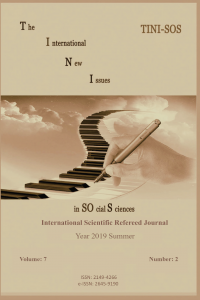Impact of TV Advertisement On Consumer Buying Behaviour A Case Study Of Libyan Consumer Buying Behavior
Öz
Abstract
This study
aims to understand the impact of TV
advertising and consumer buying behaviour with reference to fast moving consumer goods (FMCGs). The data was compiled using the 5-Likert scale with
cross-sectional data. As a sample, 150 surveys were distributed in
Tripoli-Libya and analyzed in the SPSS 23.0 program.
On this purpose of the study, primarily
literature review was conducted. To determine the impact of TV Advertisement
on consumers buying behaviour and
relationship between consumers buying behaviour, consumer perception.
Data were analyzed by using different statistical
techniques such as descriptive statistic, Correlation analysis, and regression
analysis. The results of our study are reliable and valid. That's because the
analysis results and findings show that ads have a significant impact on
consumers' buying behavior and choices
Anahtar Kelimeler
Kaynakça
- References Anjum, B., Irum, A., & Dr. Naheed. (2015). Impact Of Television Advertisement On Consumer Buying Behavior: The Moderating Role Of Religiosity In The Context Of Pakistan, 1(3), 162–185. Batra, R, J G Myers, And D A Aaker. 1995. “Group Influence And Word-Of-Mouth Advertising.” Advertising Management, 345–63. Doyle, P., & Saunders, J. (1990). Multiproduct Advertising Budgeting. Marketing Science, 9(2), 97–113. Ganeshasundaram, Raguragavan, And Nadine Henley. 2009. “Reality Television (Supernanny): A Social Marketing ‘Place’ Strategy.” Journal Of Consumer Marketing 26 (5). Emerald Group Publishing Limited:311–19. Kotler, P., & Keller, K. L. (2003). Marketing Management: International Edition. Printice Hall. New Jersey. Küçük, O. (2016). Bilimsel Araştırma Yöntemleri. Ekin Yayınları. Mccarthy, E. J. (1968). Basic Marketing: A Managerial Approach. RD Irwin. Mccarthy, Edmund Jerome, And William D Perreault. 2000. Applications In Basic Marketing. Irwin. Mcguire, William J, R E Rice, And C K Atkin. 2001. “Input And Output Variables Currently Promising For Constructing Persuasive Communications.” Public Communication Campaigns 3:22–48. McWilliams, Edward G, and John L Crompton. 1997. “An Expanded Framework for Measuring the Effectiveness of Destination Advertising.” Tourism Management 18 (3). Elsevier:127–37. Mohammadian, M. (2006). Advertisement Management. Horoufiyeh Publishing,. Nylen, David W. 1986. Advertising: Planning, Implementation & Control. Thomson South-Western. Patsioura, Fotini, Maro Vlachopoulou, and Vicky Manthou. 2009. “A New Advertising Effectiveness Model for Corporate Advertising Web Sites: A Relationship Marketing Approach.” Benchmarking: An International Journal 16 (3). Emerald Group Publishing Limited:372–86. Priya, Pankaj, Rajat Kanti Baisya, and Seema Sharma. 2010. “Television Advertisements and Children’s Buying Behaviour.” Marketing Intelligence &Planning 28 (2). Emerald Group Publishing Limited:151–69. Ramalingam, V., Palaniappan, B., Panchanatham, N., & Palanivel, S. (2006). Measuring Advertisement Effectiveness—A Neural Network Approach. Expert Systems With Applications, 31(1), 159–163.
- Vaughn, Richard. 1986. “How Advertising Works: A Planning Model Revisited.” Journal Of Advertising Research 26 (1):57–66. Woodside, Arch G. 1990. “Measuring Advertising Effectiveness In Destination Marketing Strategies.” Journal Of Travel Research 29 (2). Sage Publications Sage CA: Thousand Oaks, CA:3–8.
TV Reklamının Tüketici Satın Alma Davranışına Etkisi: Libya Tüketici Satın Alma Davranışının Bir Vaka Çalışması
Öz
Özet
Bu çalışma, TV reklamcılığı ve tüketici satın alma davranışının hızlı
satın alınan mallar referansıyla etkisini anlamayı amaçlamaktadır. Kesitsel
verilerle 5’li Likert ölçeği kullanılarak veriler derlenmiştir. Örneklem olarak
Trablus-Libya'da 150 anket dağıtılmış ve SPSS 23.0 programında analiz
edilmiştir.
Bu çalışmada temel amaç kapsamında öncelikle TV reklamının tüketici
satın alma davranışı üzerindeki etkisini ve tüketici satın alma davranışı,
tüketici algısı arasındaki ilişkiyi belirlemek üzere literatür taraması
yapılmıştır.
Veriler tanımlayıcı istatistik, korelasyon analizi ve regresyon analizi
gibi farklı istatistiksel teknikler kullanılarak analiz edilmiştir.
Çalışmamızın sonuçları güvenilir ve geçerlidir. Çünkü analiz sonuçları ve
bulgular, reklamların tüketicilerin satın alma davranışları ve seçimleri
üzerinde önemli bir etkiye sahip olduğunu göstermektedir.
Anahtar Kelimeler
Kaynakça
- References Anjum, B., Irum, A., & Dr. Naheed. (2015). Impact Of Television Advertisement On Consumer Buying Behavior: The Moderating Role Of Religiosity In The Context Of Pakistan, 1(3), 162–185. Batra, R, J G Myers, And D A Aaker. 1995. “Group Influence And Word-Of-Mouth Advertising.” Advertising Management, 345–63. Doyle, P., & Saunders, J. (1990). Multiproduct Advertising Budgeting. Marketing Science, 9(2), 97–113. Ganeshasundaram, Raguragavan, And Nadine Henley. 2009. “Reality Television (Supernanny): A Social Marketing ‘Place’ Strategy.” Journal Of Consumer Marketing 26 (5). Emerald Group Publishing Limited:311–19. Kotler, P., & Keller, K. L. (2003). Marketing Management: International Edition. Printice Hall. New Jersey. Küçük, O. (2016). Bilimsel Araştırma Yöntemleri. Ekin Yayınları. Mccarthy, E. J. (1968). Basic Marketing: A Managerial Approach. RD Irwin. Mccarthy, Edmund Jerome, And William D Perreault. 2000. Applications In Basic Marketing. Irwin. Mcguire, William J, R E Rice, And C K Atkin. 2001. “Input And Output Variables Currently Promising For Constructing Persuasive Communications.” Public Communication Campaigns 3:22–48. McWilliams, Edward G, and John L Crompton. 1997. “An Expanded Framework for Measuring the Effectiveness of Destination Advertising.” Tourism Management 18 (3). Elsevier:127–37. Mohammadian, M. (2006). Advertisement Management. Horoufiyeh Publishing,. Nylen, David W. 1986. Advertising: Planning, Implementation & Control. Thomson South-Western. Patsioura, Fotini, Maro Vlachopoulou, and Vicky Manthou. 2009. “A New Advertising Effectiveness Model for Corporate Advertising Web Sites: A Relationship Marketing Approach.” Benchmarking: An International Journal 16 (3). Emerald Group Publishing Limited:372–86. Priya, Pankaj, Rajat Kanti Baisya, and Seema Sharma. 2010. “Television Advertisements and Children’s Buying Behaviour.” Marketing Intelligence &Planning 28 (2). Emerald Group Publishing Limited:151–69. Ramalingam, V., Palaniappan, B., Panchanatham, N., & Palanivel, S. (2006). Measuring Advertisement Effectiveness—A Neural Network Approach. Expert Systems With Applications, 31(1), 159–163.
- Vaughn, Richard. 1986. “How Advertising Works: A Planning Model Revisited.” Journal Of Advertising Research 26 (1):57–66. Woodside, Arch G. 1990. “Measuring Advertising Effectiveness In Destination Marketing Strategies.” Journal Of Travel Research 29 (2). Sage Publications Sage CA: Thousand Oaks, CA:3–8.
Ayrıntılar
| Birincil Dil | İngilizce |
|---|---|
| Bölüm | Makaleler |
| Yazarlar | |
| Yayımlanma Tarihi | 5 Ağustos 2019 |
| Gönderilme Tarihi | 18 Kasım 2018 |
| Yayımlandığı Sayı | Yıl 2019 Cilt: 7 Sayı: 2 |
The International New Issues in Social Sciences, is international, Scientific, peer-reviewed Journal.
Tini-SOS journal is to evaluate scientific articles in the field of social sciences, especially based on field studies structured in accordance with scientific criteria, and conducts studies to publish studies that provide appropriate measures.

